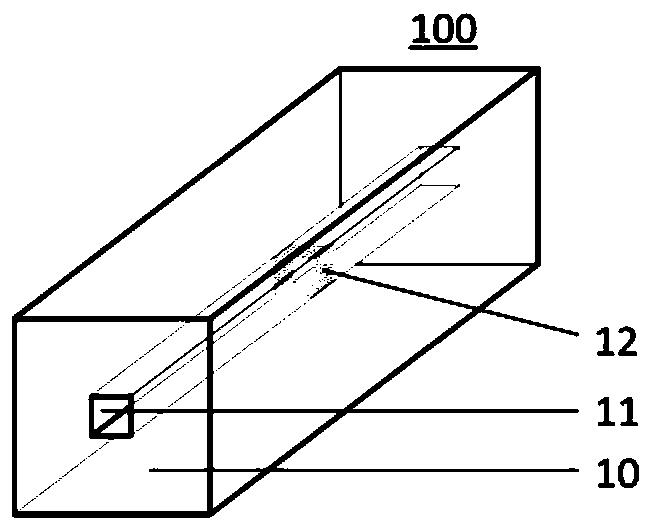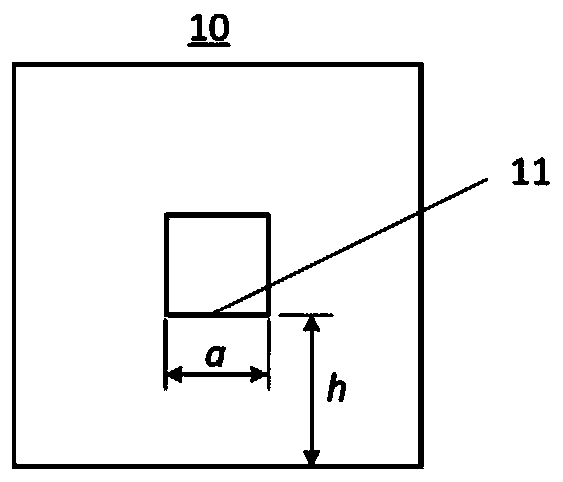Microchannel and method of making the same
A technology of microchannel and plane expansion, applied in chemical instruments and methods, laboratory utensils, laboratory containers, etc., can solve the problem that the exposure section cannot be locally modified, the surface modification of the microchannel cannot be achieved, and the section cannot have the same cross section. Surface modification, etc.
- Summary
- Abstract
- Description
- Claims
- Application Information
AI Technical Summary
Problems solved by technology
Method used
Image
Examples
Embodiment 1
[0105] In this embodiment, a PDMS microchannel (100) with a square cross-section is fabricated using a planar folding technique. Among them, refer to Figure 2a , the microchannel is a square cross-section (10), and a hydrophilic coating (12) needs to be made locally on the inner wall surface (11); refer to Figure 2b , while the side length a of the microchannel is 1 mm, and the wall thickness h is 2 mm. The specific production process is as follows:
[0106] (1) Reference Figure 2c , the square section (10) of the microchannel (100) can be decomposed into an expanded figure (30) consisting of N=4 isosceles trapezoids (20); wherein, the upper base of the isosceles trapezoid a=1 mm, height For h=2 mm, base angle θ=(180°-360° / N) / 2=45°; the upper base of the isosceles trapezoid corresponds to the inner wall surface (11) of the microchannel, and the waist of the isosceles trapezoid corresponds to the folded microchannel Bonding surface (21).
[0107] (2) design casting mold...
Embodiment 2
[0112] In this embodiment, a triangular section PDMS microchannel (200) is fabricated using planar folding technique. refer to Figure 3a , the microchannel is an equilateral triangle section (110), and the inner wall surface (111) is made with a metal film helical coil (112); the side length a of the microchannel is 1 millimeter, the wall thickness h is 2 millimeters, and the metal film substrate is 10 nanometers thick Chromium film, metal film surface layer is 50 nanometers thick gold film. The specific production process is as follows:
[0113] (1) Reference Figure 3b , the triangular section (110) is decomposed into a planar expansion figure (120) made of N=3 isosceles trapezoids (113), the upper base a=1 millimeter of the isosceles trapezoid (113), and the height is h=2 millimeters , base angle θ=(180–360 / N) / 2=30°.
[0114] (2) According to the planar expansion figure (120) design such as Figure 3c The casting mold (130) is shown, and the mold (130) is made using 3...
Embodiment 3
[0120] In this embodiment, according to the method and conditions basically the same as in Embodiment 2, a photosensitive resin microchannel with an equilateral triangular section (NOA) was fabricated by plane folding technology. The difference is that in this example,
[0121] (a) Perform steps (1)-(2) of Example 2 to obtain a casting mold (130).
[0122] (b) uniformly mix the NOA photosensitive resin prepolymer and the initiator, pour the mixed solution into a mold (130) and degas it, then cure under ultraviolet exposure, and cast to obtain a planar unfolded polymer structure.
[0123] (c) Coating a resin adhesive on the bonding surface, and folding and closing the planar unfolded structure to obtain a microchannel with a regular triangular cross-section.
PUM
 Login to View More
Login to View More Abstract
Description
Claims
Application Information
 Login to View More
Login to View More - R&D
- Intellectual Property
- Life Sciences
- Materials
- Tech Scout
- Unparalleled Data Quality
- Higher Quality Content
- 60% Fewer Hallucinations
Browse by: Latest US Patents, China's latest patents, Technical Efficacy Thesaurus, Application Domain, Technology Topic, Popular Technical Reports.
© 2025 PatSnap. All rights reserved.Legal|Privacy policy|Modern Slavery Act Transparency Statement|Sitemap|About US| Contact US: help@patsnap.com



